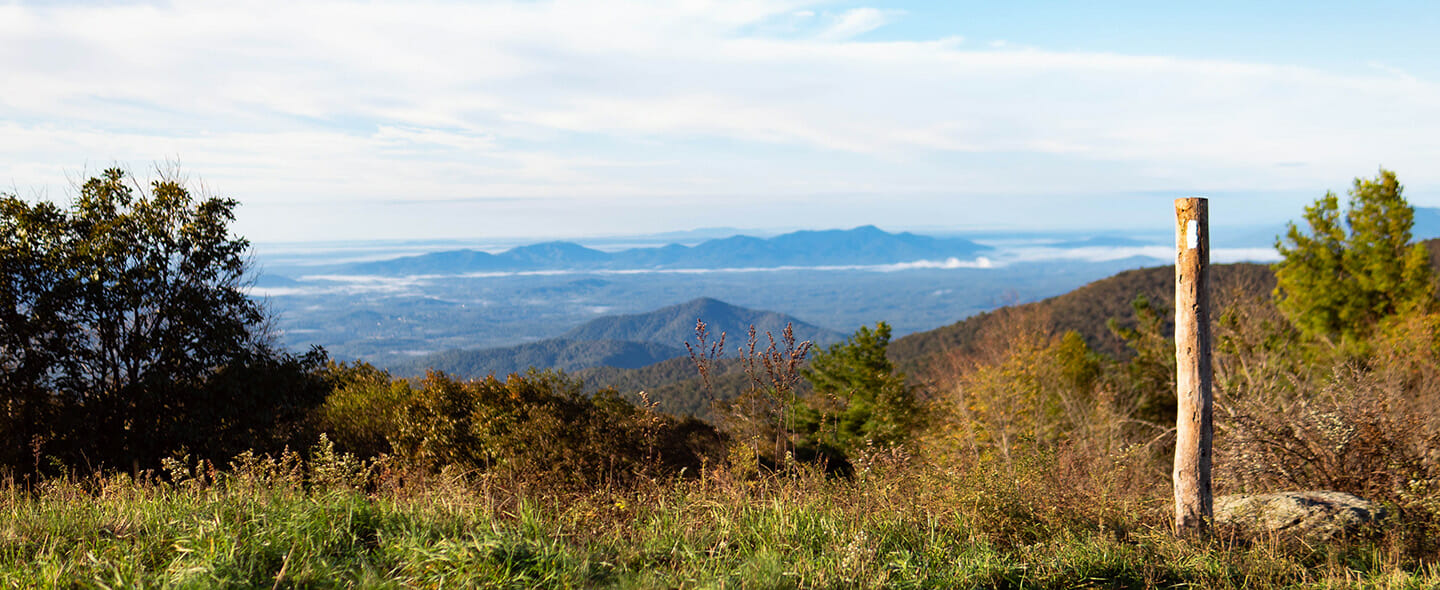The trail
The Appalachian Trail (AT) winds its way through the wilderness for a staggering 3520 km, crossing 14 Eastern US states from Springer Mountain, Georgia to Mount Katahdin in Maine. This is the longest hiking-only footpath in the world. Its beauty and the unique challenge it represents attract over 3 million visitors every year.
The AT was completed in 1937, originally to be a gateway from the East Coast cities. A place where city-dwellers could get in touch with nature. Over time it became way more than a recreational area and it is now part of the US National Park System. The Appalachian Trail Conservancy (ATC) makes sure to protect the trail and the surrounding lands for future generations. With corporate donations and a volunteer-based organization the trail is maintained year after year.
The hike within
I was only 13 years old when I first set foot on THE trail. The first few hours were the most enduring of my young life. My bag perfectly packed to full capacity for the 10-day long journey ahead, a bit over a third of my weight on my shoulders, I started to wonder what I was doing there. The minutes felt like hours and my legs were shaking. The sun was bearing down on the forest, the air was thick. I could smell the pine trees and the fresh mud on the tree roots.
After a few days, the city seemed so far away. The smells, the breeze, the sun through the leaves, the woodpeckers digging in the bark, the gentle flow of water, the branches cracking under my steps; everything started to make sense and I felt the rhythm of my mind slowing down. I had space to think and reflect.
My first hike in the AT was organized by the Tekakwitha Summer Camp in Maine with about 10 other girls. This experience was life-changing, profoundly marking my teenage soul. Coming from a loving middle-class Canadian family, going through tough times was foreign to me, so 10 days without civilization, computers, phones or the usual comfort was a real revelation.
But the beauty of it is that the deeper you get in the woods, the less comfort you need. The lighter you want to travel, the more connected to yourself you get. You learn to persevere, to be humble in front of nature, to contemplate, to be content. You find somehow piece by piece an idea of your truth. You learn to help others, to respect hikers you meet along the way.
Aren’t we all so small in front of nature’s force. If something happens, you might be hours or even days from help, so solidarity is strong, comforting, necessary.
I loved it so much that I went back 3 more times for long hikes in my teenage years. Another 10 days, then 14, then 17 days (finishing at the top of Mount Katahdin). Put all together I ended up hiking the whole state of Maine, where you can find some of the most challenging section of the AT. That is 282 miles – 455km and something to be proud of.
I promised myself to go back every year, but life being what it is, I manage to go back here and there only for short hikes and mostly in the Canadian section. The AT continues in Eastern Canada as the International Appalachian Trail (IAT), from Mount Katahdin to Belle Isle in Northern Newfoundland on the Atlantic Ocean.
The thru-hike
Impossible to talk about the AT without mentioning the thru-hiking – hike of the entire AT in 12 months or less. It can be completed in one go or in sections. The ATC keep records of thru-hikes since 1937. As of today, we estimate about 22 000 hikers made and registered it with the ATC.
The first public thru-hike was done in 124 days by WWII veteran Earl Shaffer. He saw in the AT an opportunity to heal from the war and started his hiking journey in April 1948 as he wanted to walk the army out of his body.
The first female thru-hiker was Emma Rowena Gatewood, a 67 year-old grandma from Ohio. She also became the first person to thru-hike the AT three times and her fame did help attract attention and significant interest to maintain the AT.
I met some thru-hikers when I was walking my humble few miles. I never had the commitment of the thru-hikers but I was deeply impressed by the exploit, the determination, the act of diving into the wild for months.
On top of the obvious physical and technical challenge, it is a mind game where the strength to keep going comes from the heart, from the soul. Some of them hiked the whole trail with only a shower curtain and sneakers or only a blanket and no tent. When there is a will there is definitely a way!
Feeling keen to give it a try? Want to join the 3 000 people attempting the thru-hike every year? Beware, only 1 out of 4 actually makes it! Get in shape and plan an intense 5-7 months for this life changing experience!
Get your bearings
To find your way in and out the trail, through the forest, up and down mountains, to a shelter, to a sneaky short-cut or a water point, you need to follow the white and blue blazes. No matter if you are long-distance backpacking or on the trail for a few hours or days you need to know about these 6-inch-long by 2-inch-wide paint marks. The markers, or blazes, are repainted every couple of years on trees, posts and rocks by a dedicated team of volunteers and are your best friend.
To simplify it, the white blazes are marking the main trail. The approximate numbers of blazes is about 165 000. From a blaze to the next you make your way through, being careful if you see two blazes on one tree, this might indicate a tricky, sharp turn.
White blazes
AT purists, or white-blazes, are hiking past every single white blaze on the trail and if they have to get out of the trail for any reason, like a resupply station or a medical emergency, they return to the exact same spot before continuing their way. The ATC even painted a white blaze on the Kennebec River Ferry to mark it as the official route.
Blue blazes
The blue-blazed trails branch out the AT; to get to a viewpoint, a campground or a lean-to, or a water source. It could as well indicate an alternate route, a shot-cut, a path to avoid a steep climb. Short cuts and alternative routes in blue are a no go to purists.
You might have guessed it, there is actually an on-going debate between white and blue blazes in the hiking community!
Yellow blazes
And who are the yellow-blazes? Yellow-blazes are referring to the yellow lines on the road. So yellow-blazes hitch or get a ride at some point on their journey. It might feel like cheating, but in some situations, it is necessary, for example if wildfires are raging, if you want to meet up with friends in a different section of the trail or get medical attention.
Along the way, you will find shelters, also called lean-to. A very simple structure: a lean-to has a roof, a wooden floor and 3 walls, and most are near a water point. Some lean-to have food storage equipment to protect food from bears as you don’t want to attract them near you camp site.
I used to find some rustic guest books in these shelters where hikers leave notes and messages. I loved browsing around, turning pages, following someone else’s story. It could be truly inspirational. I loved leaving a note, hoping someone would read it one day.
Wildlife
While on the Appalachian Trail or really any trail – Be respectful. You are in the animal kingdom. And be careful as well. Wildlife is majestic and dangerous and you are in their home, on their territory.
Here is a non-exhaustive list of animals you might spot on the trail:
- Black Bear
- Coyote
- Fox
- Moose
- Deer
- Squirrel
- Birds
- Snakes
- Praying Mantis
In addition to a huge moose, I stumbled upon a bear at dusk on my last tour in the AT. You might think you are ready and you learnt what to do… but this is really impressive. Instinct and fear take over. I swear, I have never run that fast in my life when I saw those two big eyes staring at me in the woods. I just ran, screamed and completely forgetting about my emergency whistle.

Tiptoeing
A short hike
Of course, you can go for a short hike on the AT. Some sections, closer to towns or villages are easily accessible for a short hikes, easy trips.
A day trip
For example, you can get a taste of the AT in a one-day trip to Mount Katahdin in Baxter State Park. The round trip is about 8-12 hours and is suitable for beginners if you take the Saddle Trail. Easy way up and beautiful views.
If you want to spice it up a bit, the famous Cathedral Trail is certainly the toughest choice but it is worth it and the views are spectacular, better calculate a minimum of 10 hours. Mount Katahdin is the culminating point of weeks or even months of walking for a lot of hikers and has this particular feverishness.
A few days
Another nice trail: Springer Mountain, Georgia is perfect for a spring hike when the weather is already warm in the South. This is a eight-day hike in northern Georgia and southern North Carolina. Close by, you can find the Benton MacKaye Trail, which is the original AT footpath.
There are million of ways to approach the AT beast. There is definitely a way for you.






